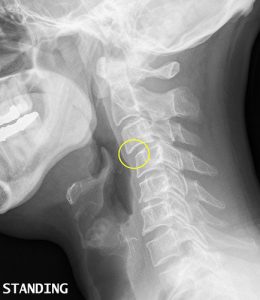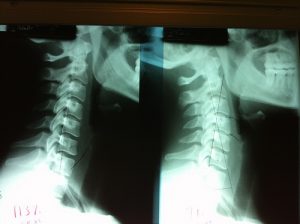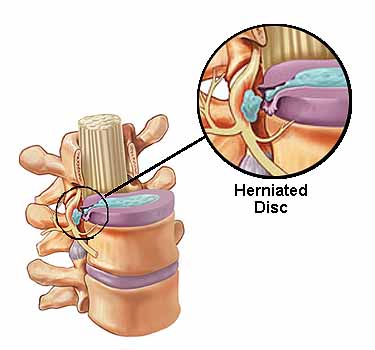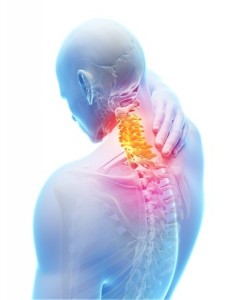The Body & Mind and Connection of Whiplash?
Clear Lake Chiropractor
Clear Lake Chiropractor Comments: The term “whiplash” refers to an injury to the neck muscles, the muscle attachments (tendons), ligaments, and sometimes the disks that lie between the vertebral bodies of the spine. In a rear-end collision, the cause of whiplash occurs from a sudden, rapid acceleration of the body and neck as the car is pushed forwards. In these first moments following impact, the head remains in the same place while the body is propelled forward. This is followed by a “crack-the-whip” movement of the head and neck when the muscles in the front of the neck stretch like rubber bands and suddenly spring the head forwards, all occurring in less than 1 second. The force on the head and neck is further intensified if the seat back is too springy, or angled back too far. Also, if the headrest is too low, the head may ride over the top and more injury can result.
Treatment of whiplash

The treatment of whiplash varies from “watchful waiting” to a multidisciplinary team approach that includes neurology, physical therapy, chiropractic, psychology, and possibly surgery (rare). In an article published in the American Journal of Physical Medicine and Rehabilitation, the relationship between clinical, psychological and functional health status factors was investigated in a group of patients with chronic whiplash-associated disorder (WAD). A total of 86 patients with chronic WAD participated in the study and outcomes were tracked using questionnaires that measure pain, disability and psychological issues including depression, anxiety and catastrophizing. Physical examination factors included measuring the cervical range of motion. An analysis of the degree of neck disability and the relative contribution of physical vs. psychological factors revealed catastrophizing and depression played greater roles than did cervical range of motion. This suggests psychological factors play an important role in the outcome of whiplash.
Finding a Chirpractor
The importance of this is that more than just the physical factors like range of motion should be focused on when treating chronic whiplash patients. Answering the patient’s questions, explaining the mechanism of injury and how that relates to their specific condition, and addressing depression, anxiety, coping, and other psychological issues is very important. Discussing treatment goals with patients is also very important. For example, making light of the injury by stating something like, “…you’ll be fine after the treatments,” may harm the patient as anything short of “fine” may be interpreted as failed treatment by the patient. It is also important not to paint too dismal of a picture as that can have negative psychological effects as well, as this may suggest that they will never improve. Explaining the difference between “hurt” and “harm” is of great value to the chronic whiplash patient as they are often told, “if it hurts, don’t do it.” This sends an unfortunate message to the patient that any activity where an increase in pain occurs is “bad” when in fact, that activity may help the patient get better in the long run. This can make or break an acceptable outcome as many may feel like they shouldn’t do anything and this can lead to unemployment, boredom, and the many psychological issues previously described. The best advice is to remain active and try to ignore discomfort by staying within “reasonable activity boundaries.” Reasonable activity tolerance is learned as time passes and trying different activities for different lengths of time. This type of coaching should be at the center of chronic whiplash management rather than over focusing on physical factors such as range of motion. If you would like to know more about whiplash or would like treatment, please contact your Houston chiropractor, Beecher Chiropractic!
Is It Really Neck Pain?
To download a copy of this week’s newsletter, please click here.
Houston Area Chiropractor Comments: A 48-year-old male had left sided neck pain with intermittent left arm tingling, numbness, and aching for 2.5 months. The pain was described as a deep nagging ache on the left side of the neck with a more intense pain in the left shoulder blade that occurred without any specific activity. Also, no particular position of the neck or head changed the symptoms in the neck or left arm. The patient described having periodic episodes of neck and left arm pain/numbness 4 or 5 times over the last 10 years, and he felt that this episode was similar to the previous episodes. He had utilized chiropractic treatment previously with good results and was considering calling for an appointment once again.

Everything “looks and sounds” like a neck condition with an associated pinched nerve causing pain and tingling radiating down the arm – but is it?
After carefully questioning, it was discovered that no specific date of onset could be tied to a trauma (specific injury), over-use activity, or any other identifiable cause. Similarly, he stated that no specific position of the head/neck or arm changed the intensity or length of time the pain lasted. This is unusual for a pinched nerve in the neck as the nerves are stretched when the arm hangs down at the side increasing the pain, and less stretched when the arm is raised over the head resulting in less arm symptoms. Another inconsistent finding was that the whole arm rather than a specific part of the arm was symptomatic. Usually, a pinched nerve follows a specific course down the arm affecting either the 4th and 5th fingers or the thumb side of the hand, but not the whole arm and hand. The physical examination was fairly typical for neck pain sufferers – limited ranges of motion of the neck, neck pain reduction with manual traction and increased with compression tests. However, there were no arm symptom changes during the neck ranges of motion tests, compression tests, or elevating the arm.
These history and examination findings should alert the health care provider of a possible “organic” cause for the symptoms rather than the “pinched nerve” diagnosis. When considering a list of possible “organic” causes, heart disease must be first on the list since it has life threatening potential. In the case presentation above, the patient was indeed having a heart attack where the blood vessels to part of the heart wall were blocked and the blood carrying oxygen to the heart muscle couldn’t get through, thus was causing the “referred pain” to the left side of the neck, shoulder blade and down the left arm. It is important to know that this heart related referred pain pattern never involves the right arm – only the left. Other potential symptoms can include left jaw (TMJ) pain, and the more obvious left sided chest pain, even though these were not present in this case.
We welcome you to contact our office for a thorough evaluation or to answer any questions concerning you, your loved ones, or friends concerning neck pain, with or without arm complaints. The good news is that it is probably your neck and not your heart that is causing the symptoms. Most importantly, rest assured that we ALWAYS consider all possibilities.
Dr. Ward Beecher practices at Beecher Chiropractic Clinic at 1001 Pineloch, Ste 700 Houston, TX 77062. You can schedule an appointment at BeecherChiropractic.com or by calling (281) 286-1300. If you have any questions regarding this blog, please comment below!
The Neck and Headache Connection
The Neck and Headache Connection
Clear Lake Chiropractor Comments: Patients with headaches also commonly complain of neck pain. This relationship is the rule, not the exception and therefore, treatment for headaches must include treatment of the neck to achieve optimum results. The term, “cervicogenic headaches” has been an accepted term because of the intimate connection between the neck and head for many years. There are many anatomical reasons why neck problems result in headaches. Some of these include:
- The first 3 nerves exiting the spine in the upper neck go directly into the head. They penetrate the muscles at the top of the neck near the attachments to the skull and therefore, any excess pressure on these nerves by the muscles or spinal joints will result in irritation and subsequent pain.
- The origin or nucleus of the 5th cranial nerve called the Trigeminal, innervates the sensation to the face and is located in the upper cervical region near the origin of the 2nd cervical spinal nerve, which innervates sensation to the back of the head up to the top. Therefore, problems located in the upper neck will often result in pain radiating up from the base of the skull/upper neck over the top of the skull to the eyes and /or face.
- The 11th cranial nerve that innervates the upper shoulders and muscles in the front of the neck arises from the top 5 to 7 spinal cord levels in the neck. Injury anywhere in the neck can result in spasm and pain in these large muscle groups.
- Other interconnections between the 2nd cervical nerve and trigeminal/5th cranial nerve include communication with the 7th cranial / facial nerve, the 9th cranial / glossopharyngeal nerve, and the 10th cranial / vagus nerve. These connections can affect facial muscle strength/movements, taste, tongue and throat movements, and stomach complaints such as nausea from these three cranial nerve interconnections, respectively.

Headache flickr photo by Peter Hellberg shared under a Creative Commons (BY-SA) license
When patients seek treatment for their headaches, a thorough examination of the neck, upper back, and cranial nerves is routinely performed for the above reasons. It is common to find upper cervical movement and vertebral alignment problems present in patients complaining of headaches. Tender points located between the shoulder blades, along the upper shoulders, on the sides of the neck and particularly, at the base of the skull are commonly found. Pain often radiates from the tender point over the top of the skull when pressure is applied in the upper neck/base of the skull area. Tenderness on the sides of the head, in the temples, over the eyes, and near the jaw joint are also common. Traction or pulling the head to stretch the neck is often quite pain relieving and this is often performed as part of the chiropractic visit and can also be applied at home with the use of a home cervical traction unit. Chiropractic adjustments applied to the fixated or misaligned vertebra in the upper neck often brings very satisfying relief to the headache sufferer. Exercises that promote movement in the neck, as well as strengthening exercises are also helpful in both reducing headache pain and in preventing occurrences, especially with stress or tension headaches.
Dr. Ward Beecher practices at Beecher Chiropractic Clinic at 1001 Pineloch, Ste 700 Houston, TX 77062. You can schedule an appointment with a Clear Lake chiropractor by calling (281) 286-1300. If you have any questions regarding this blog, please comment below!
Neck and Arm Pain – The Herniated Disc?
To download a copy of this newsletter, please click here.
Clear Lake Doctor Comments: Patients that present with neck pain along with arm numbness, pain, and/or weakness, often ask, “…what’s causing this pain down my arm?” The condition is often caused from a bulging or herniated disc pinching a nerve in the neck. The cause of this complaint can include both trauma as well as non-traumatic events. In fact, sometimes, the patient has no idea what started their condition, as they cannot tie any specific event to the onset.
The classic presentation includes neck pain that radiates into the arm in a specific area as each nerve affects different parts of the arm and hand. Describing the exact location of the arm complaint
such as, “I have numbness in the arm and hand that makes my 4th and pinky fingers feel half asleep,” tells us that you have a pinched C8 nerve. This nerve can also be pinched at the elbow and make the same two fingers numb. The difference between the two different conditions is when the nerve is pinched in the neck, the pain is located from the neck down the entire arm and into digits 4 & 5 of the hand. When the nerve is pinched at the elbow, the pain/numbness is located from the elbow down to the 4th & 5th digits, but no neck or upper arm pain exists.
Examination findings usually include limitations in certain cervical (neck) ranges of motion (ROMs) – usually in the direction that increases the pinch on the nerve. Another common finding is the arm is often held over the head because there is more stretching on the nerve when the arm is hanging down and pain in the neck and arm increases. Hence, raising the arm over the head reduces the neck/arm pain. To determine where the nerve is pinched, there are a number of different compression tests that can recreate or increase the symptoms. Some compression tests include placing downward pressure on the head with the head pointing straight ahead, bent or rotated to each side. Other compression tests are performed by pressing in areas where the nerve travels such as in the lower front aspect of the neck, in the front of the shoulder where the arm connects to the chest/trunk, at the elbow and at the wrist. If there is a pinched nerve, numbness, tingling and/or pain will be reproduced when pressure is applied to these regions. Other tests include testing reflexes and muscle strength in the arm. When a nerve is pinched, the reflexes will be sluggish or absent and certain movements in the arm are weak when compared to the opposite side. Another very practical test is called the cervical (neck) distraction test where a traction force is applied to the neck. When neck and/or arm pain is reduced, this means there is a pinched nerve. This test is particularly useful because when pain is reduced, the test supports the need for a treatment approach called cervical traction. Other forms of care that can be highly effective include spinal manipulation, spinal mobilization, certain exercises, physical therapy modalities, and certain medications.
If you, a friend, or a loved one are struggling with a herniated disc in the neck with associated arm complaints, we will properly assess your condition, run the appropriate tests, and administer the appropriate care that is needed. We also coordinate services with other health care providers when necessary. This recommendation may represent one of most significant acts of kindness you can give to those that you care about.
Dr. Ward Beecher practices at Beecher Chiropractic Clinic at 1001 Pineloch, Ste 700 Houston, TX 77062. You can schedule an appointment at BeecherChiropractic.com or by calling (281) 286-1300. If you have any questions regarding this blog, please comment below!
Whiplash – The Cause of Pain
To download a copy of this newsletter, please click here.
Houston Chiropractor Comments: Many patients ask the question: “…why do I hurt so much now, and hardly hurt at all right after the accident?” Another common question is: “…why neck pain after a minor car collision can last so long?”
 A study that investigated chronic pain and dysfunction in whiplash cases reported a soft tissue origin for injuries associated with low-speed collisions. This means the pain comes from the muscles, ligaments, joint capsules, the disk, but not from a pinched nerve that would send pain down the arm and/or create hand numbness or grip weakness. The study also reported the point at which the neck buckles would only take one fifth to one-fourth of the weight of the person’s head (approximately 2.5 to 3 pounds) if one were to remove all of the supporting muscles, ligaments, and joint capsules. With the muscles and soft tissues intact, there is a very complex buckling pattern that occurs in the neck during most rear-end collisions where the lower half of the neck bends opposite to that of the upper half creating an S-shaped curve (when looking at the neck from the side). When this occurs, the vertebrae in the lower half of the cervical spine extend backwards while the upper half flex forwards, stretching the ligaments beyond the maximum elastic point and tissue tearing occurs. When ligaments stretch or strain, microscopic tearing starts at only 3-5% of tissue strain and when the strain reaches 7-8%, the ligament begins to lose its load carrying capacity and more significant tearing occurs. Unfortunately, none of this can be seen on a standard x-ray and usually goes undiagnosed.
A study that investigated chronic pain and dysfunction in whiplash cases reported a soft tissue origin for injuries associated with low-speed collisions. This means the pain comes from the muscles, ligaments, joint capsules, the disk, but not from a pinched nerve that would send pain down the arm and/or create hand numbness or grip weakness. The study also reported the point at which the neck buckles would only take one fifth to one-fourth of the weight of the person’s head (approximately 2.5 to 3 pounds) if one were to remove all of the supporting muscles, ligaments, and joint capsules. With the muscles and soft tissues intact, there is a very complex buckling pattern that occurs in the neck during most rear-end collisions where the lower half of the neck bends opposite to that of the upper half creating an S-shaped curve (when looking at the neck from the side). When this occurs, the vertebrae in the lower half of the cervical spine extend backwards while the upper half flex forwards, stretching the ligaments beyond the maximum elastic point and tissue tearing occurs. When ligaments stretch or strain, microscopic tearing starts at only 3-5% of tissue strain and when the strain reaches 7-8%, the ligament begins to lose its load carrying capacity and more significant tearing occurs. Unfortunately, none of this can be seen on a standard x-ray and usually goes undiagnosed.
Many variables exist that make assessing the amount of tissue damage difficult to predict or understand. One of these variables is the strength and amount of elasticity of a ligament prior to tearing. Also, the age, gender, and phenotype – that is, skinny, normal, or over weight – makes a difference. Generally, due to a reduced muscle mass in a female compared to most males, women are at greater risk of injury. The position of the person in the car, whether a seatbelt was used or not, if the head was turned before impact, if the collision was anticipated prior to impact, the speed at which one person compared to another can voluntarily contract a muscle are all additional factors affecting the degree of injury and corresponding pain. Another factor is the size of the spinal canal (the place where the spinal cord runs from the brain to the low back) as some people are born with narrow canals, making them more susceptible to injury. Other neurological variables include the degree of the excitability of the nervous system as the more excitable, the lower the pain threshold and pain is perceived more quickly. The type of pain from the deep tissues (ligaments, joint capsules, etc) is different than pain arising from superficial tissues as the former lasts longer and doesn’t follow known neurological pathways into an arm. Also, over time, if pain becomes chronic (pain lasting >3 months), a significantly lower pain threshold is found in these cases vs. normal control subjects.
Hence, when discussing your case with our office, it is important that you share your history of the accident, the time it took after the impact for symptoms to be initially noted, whether it is gradually worsening over time, and any other symptom that is unique to your situation that may not have been discussed here.
Dr. Ward Beecher practices at Beecher Chiropractic Clinic at 1001 Pineloch, Ste 700 Houston, TX 77062. You can schedule an appointment with the best chiropractor in Houston or by calling (281) 286-1300. If you have any questions regarding this blog, please comment below!
Your Neck is Your Life Line
Chiropractor in Clear Lake Comments: The nervous system is the master control network for your body, directing virtually every function and action, from monitoring your life needs, to precisely responding to threats to your health.
Each system, from your heart and blood vessels, to your digestive and immune systems, is directed through nerve impulses originating in your brain or spinal cord that travel through its protective bony structure: the spinal column.
The neck region is the most vulnerable region of the spine to injury. Indeed, even death can be brought through significant trauma to the neck. When the trauma is not fatal, the consequences can still be severe, such as when paralysis strikes.
Most people will not experience these severe injuries, however sprains of the delicate ligaments with subluxation (misalignment) do commonly occur. Despite the injury being smaller, their location (the neck) makes their impact more profound. Functions throughout the body can be impaired when the nerves in the upper neck are compromised.
Within chiropractic, there are specialists who focus their entire care on the uppermost two vertebrae of the spine.
Because every nerve passes through the neck, if irritation or compression is present, virtually any system of the body can be affected. The point being is that a neck disorder will not necessarily just cause neck pain or headache. Dizziness, digestive problems, fatigue, high blood pressure and generally reduced quality of life are some of the symptoms patients commonly experience.
If you have suffered a severe whiplash, you may have noticed far more than neck pain or a stiff neck. Indeed, recent research suggests whiplash needs to more thought of as a whole body disorder.
We take these injuries in our office and address them in both a specific and comprehensive manner. Most patients who have suffered a neck trauma will require x-rays to analyze the posture of their spine. X-rays may also need to be taken in motion to test the stability of your ligaments and to determine precise levels of impaired movements. Without this road map, it is difficult to determine how care should be directed and factors that could influence your long-term prognosis, such as degeneration.
Our health care team is dedicated to drugless natural methods to restore vitality. We try to work with your body with techniques that don’t carry the all too common side effects commonly seen with long-term drug use or surgery. If you’re suffering from neck pain in Houston, we will provide the relief you need and take steps to prevent further damage to your neck and spine.
Dr. Ward Beecher practices at Beecher Chiropractic Clinic at 1001 Pineloch, Ste 700 Houston, TX 77062. You can schedule an appointment with the best chiropractor in houston by calling (281) 286-1300. If you have any questions regarding this blog, please comment below!
Could Neck Problems Be Affected By Your Posture?
Clear Lake Chiropractor Comments: While most of us have a look in the mirror at least once a day, few of us look at our appearance from a different angle, such as from the side. But, the view from the side can be quite revealing if you suffer from chronic neck pain in Houston.
First, note the position of your head in relation to you shoulders. Is it right above the shoulders or does it lean forward from your chest? If it does, this would be called forward head posture, and can come from a problem in your neck. Lower areas of your spine can also cause this problem. Some of us have increased our weight over the years with much of it added to our abdominal region. Because of this increased core weight, the body must counter-balance the weight gain by causing the lumbar spine to “sway- back.”
While this “sway-back” problem can create pain in the lumbar spine, it can also have far reaching effects in the posture of the neck. Usually someone with a protruding stomach and sway back will have somewhat rounded shoulders and a forward head posture. If treatment is only directed at the neck without considering how other areas may affect the stability of the neck, then the results may be less than optimum.
In an accident, many areas of the body can potentially be injured.
As a chiropractor, I not only look at your primary injuries but also how mechanically one area of the spine can affect a distant area. These more distant areas can cause neck pain by referral or they can impede complete recovery because the body is compensating for abnormal posture or movement elsewhere.
X-rays of the full spine can show this abnormal posture as can a detailed postural analysis from our office.
So do you like what you see when you view your posture from the side? If your posture leaves something to be desired, or you’re wondering whether your neck problem could be improved by changing another part of your spine, then it is important to be thoroughly checked. Just examining the neck after a whiplash may leave some injuries undiscovered. Are there tender spots in other areas of the spine? Does your overall upright posture seem lacking?
Dr. Ward Beecher practices at Beecher Chiropractic Clinic at 1001 Pineloch, Ste 700 Houston, TX 77062. You can schedule an appointment at BeecherChiropractic.com or by calling (281) 286-1300. If you have any questions regarding this blog, please comment below!
Whiplash Problems Down the Road
To download a copy of this newsletter, please click here.
Clear Lake Chiropractor comments: Whiplash injuries of the neck and spine commonly occur in motor vehicle collisions. Even minor impacts with little vehicle damage can put significant stress on the spinal ligaments, disks, and delicate nerves. Some people get symptoms right after the accident (which is a very bad sign) but most people feel somewhat unscathed, at least initially.
It’s important to think how spinal injuries can affect you over the long term. When ligaments are injured, there can
be substantial changes over the years, such as arthritis and disk degeneration.
A study in the science journal SPINE (Dec. 15, 1994) looked at fifty patients with MRI and bending x-rays, one and five years after injury. The researchers found that neck pain persisted in 24/50 (48%) patients and radiating pain developed within 6 weeks in 19 patients or 38%. Radiating pain occurs when a disk protrudes and bulges onto a nerve root exiting your spinal column. In patients with these persistent symptoms, the MRI was helpful in showing the disk injury.
Although surgery is considered by many, most patients do well under conservative, even minimal care. It’s important to consider non-surgical options first, since surgery does entail substantial risks, and how well it works is also subject to debate.
X-rays and palpation are used to see the posture of your neck and how the vertebrae move in stressed positions. These tests can help determine how your spine functions and whether the disk is injured and/or also if you have pre-existing signs of arthritis, which can impair how you resist and recover from trauma.
Chiropractic adjustments are directed at reducing pain and improving mobility in spinal areas that are blocked. In general it’s important to keep your neck moving while you recover. Staying in bed and not moving the spine at all are not advised since this can impair recovery. Even patients with severe injuries can have some movements preserved and these should be encouraged.
Because symptoms and even disk disease can show up later, it is important to have a detailed neurological examination following a neck injury. Whiplash trauma is significant, especially when you consider how many patients still suffer years down the road with neck and arm pain. Getting diagnosed properly is the first step to determining what type of care will be best for you.
Dr. Ward Beecher practices at Beecher Chiropractic Clinic at 1001 Pineloch, Ste 700 Houston, TX 77062. You can schedule an appointment at BeecherChiropractic.com or by calling (281) 286-1300. If you have any questions regarding this blog, please comment below!
Headaches from the Neck?
To download a copy of this newsletter, please click here.
Chiropractor in Clear Lake City, TX comments: Cervicogenic headache is the term used to describe a headache that has its cause in the neck region. It used to be thought headaches were caused by something in the head itself, but researchers have now learned that neck injuries can produce head pain.
A study from Norway (Acta Neurol Scand 2007;Nov.20; Sjaastad O, Bakketeig LS) showed that about 4% of the population will have this type of headache. Taking medications to cover the pain will not ultimately correct a mechanical neck problem.
The symptoms of a cervicogenic headache are as follows: one-sided head pain and same side shoulder and arm pain. Patients also have limited mobility of the neck region. Rarely a patient may also have a migraine trait such as nausea, vomiting, or throbbing sensations. Because of these different signs from a typical migraine headache a physician may have overlooked the neck as a potential source for the cause of your head pain. Self-diagnosing your headache can be even worse since potentially serious causes of your head pain, such as high blood pressure may go undiscovered and left untreated. In any case it’s unlikely that your headache has been caused by a deficiency of pain pills in your diet. There are also unintended side effects that have to be considered when weighing any health care option.
Another study from Norway (Funct Neurol 2007;22:145; Drottning M, Staff PH, Sjaastad O) looked at causes of cervicogenic headaches, specifically whiplash injuries of the neck. In this study, 587 whiplash patients were followed over a six-year period. About 8% of the whiplash sufferers developed a cervicogenic headache six weeks after the initial trauma. Thirty-five percent of these patients were still suffering six years later.
Our clinic specializes in the treatment spine-caused head pain especially cervicogenic headache. To determine this we have to perform a comprehensive examination of your spine to see if sprains of your cervical or thoracic joints are present and review whether you’ve suffered a trauma in years past that could have affected the posture and mobility of these delicate spinal structures.
For patients who do not go down the road of medications for treating their neck pain in Houston, chiropractic care can be a more healthful option.
Dr. Ward Beecher practices at Beecher Chiropractic Clinic at 1001 Pineloch, Ste 700 Houston, TX 77062. You can schedule an appointment at BeecherChiropractic.com or by calling (281) 286-1300. If you have any questions regarding this blog, please comment below!
Dr Beecher’s January 26 Weekly Chiropractic Newsletter
To download Dr. Beecher’s Weekly Newsletter , please click here!
WEEKLY HEALTH NEWS UPDATE
Week of Monday, January 26th, 2015
Mental Attitude: Are You Pre-Wired to Be Bilingual? Some brains appear to be pre-wired to acquire a second language, according investigators who analyzed MRI scans of native English speakers who were asked to study Chinese vocabulary for six weeks. The pre-study MRI scans of those who were most successful at learning Chinese revealed a greater number of neural connections in the areas of the brain associated with some thinking and language skills. Study co-author Dr. Ping Li adds that, “[The brain] becomes more connected and integrated after learning [but] the brain networks of the more successful learners are better connected even before learning takes place.” It’s not yet clear what percentage of people are pre-wired to excel at learning a second language, and it’s not known if training can improve this type of brain wiring. Journal of Neurolinguistics, May 2014
Health Alert: Over 16 Million Children Live in States Where They Can Buy e-Cigarettes Legally! While 28 states have enacted laws forbidding the sale of electronic nicotine delivery systems (ENDS, which include e-cigarettes) to minors during the previous two years, the Centers for Disease Control and Prevention (CDC) reports that 10 states in the United States still lack laws prohibiting the sale of ENDS to children. According to Dr. Tim McAfee, director of CDC’s Office on Smoking and Health, “While ENDS may have the potential to benefit established adult smokers if used as a complete substitute for all smoked tobacco products, ENDS should not be used by youth and adult non-tobacco users because of the harmful effects of nicotine and other risk exposures, as well as the risk for progression to other forms of tobacco use.” Centers for Disease Control and Prevention, December 2014
Diet: Folic Acid Vital Before and During Pregnancy to Reduce Risk of Small Gestational Age. Women who take folic acid prior to conception appear to be less likely to have babies that are small for their gestational age, which can cause an array of health complications. Folic acid is a B vitamin that is already highly recommended for women of a childbearing age, as it reduces the risk of a child developing neural tube defects, such as spina bifida. The study found that the highest rates of small gestational age occurred among babies whose mothers had not taken folic acid before conception or during pregnancy. BJOG, November 2014
Exercise: Older Individuals Who Diet Without Exercising Lose Muscle Mass. A past study revealed that when older individuals diet without exercising, they tend to lose lean muscle while older dieters who are physically active don’t experience any muscle loss. This is important as older people tend to lose muscle mass as they age which may interfere with their ability to perform daily activities. Journal of Applied Physiology, September 2008
Chiropractic: Technology Use Can Increase Risk of Neck Pain. Experts are concerned that the increasing prevalence of technology may result in more pain among frequent users. Dr. Kenneth Hansray recently studied the issue of poor posture and how it affects the body, especially when using a cell phone or smart device. When the neck is in a neutral position, the head weighs about 12 pounds (~5.4 kg). Dr. Hansray found that when the head is tilted 15 degrees forward, stress on the neck increases to 27 pounds (~12.2 kg), at 45 degrees it increases to 49 pounds (~22.2 kg), and at 60 degrees it increases to 60 pounds (~27.2 kg). He adds, “When you have such aggressive stressors on the neck, you get wear and tear on the spine… You can develop tears within the disk, or even get a slipped or herniated disk.” The take-home message is to watch your posture and make changes regarding how you use your technology to avoid pain. If you do suffer from problems, your chiropractor can help by addressing posture, giving you specific exercises, and providing therapy to reduce your pain. Surgical Technology International, November 2014
Wellness/Prevention: Keep Your Feet Happy & Healthy. Because they are your body’s foundation, it is very important to take care of your feet to avoid pain and maintain their function. The American Podiatric Medical Association recommends the following for keeping your feet happy: moisturize daily, stretch and/or massage daily, get a pedicure, and wear comfortable shoes. American Podiatric Medical Association, December 2014
Quote: “It is useless to attempt to reason a man out of a thing he was never reasoned into.” ~ Jonathan Swift
This Weekly Health News Update is compliments of Dr. Ward Beecher and Beecher Chiropractic Clinic. If you have any questions or comments, please contact us at 281-286-1300 or BeecherChiropractic.com .

